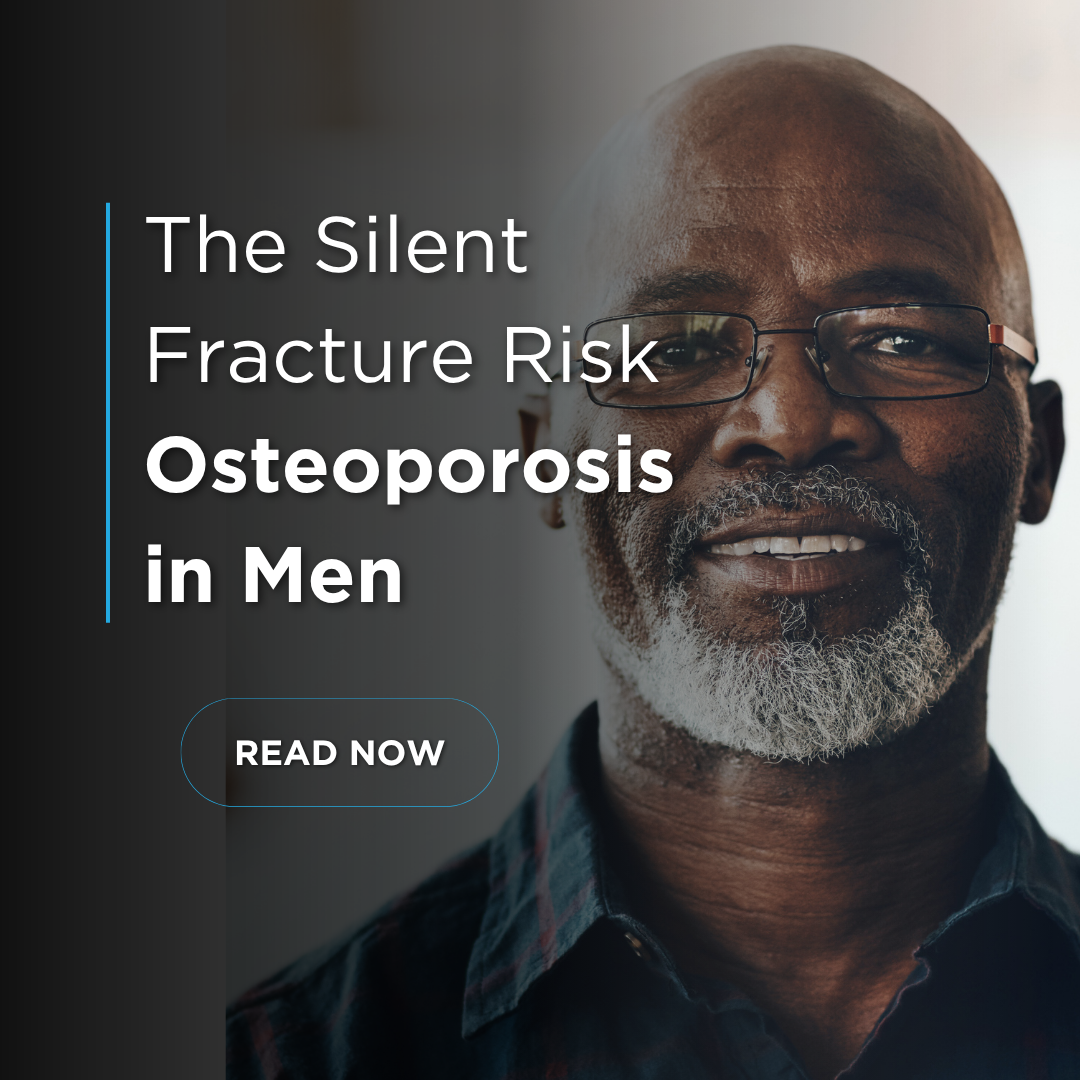By: David A Fein, MD
Medical Director
Princeton Longevity Center
It strikes with no warning. You’re standing in line at the checkout counter when you hear a loud crack and then you are on the floor. You can’t get up because now you have a fractured hip. It didn’t break because you fell. It broke because for years your bones had been slowly becoming thinner and weaker until finally merely holding up your weight became too much and the bone snapped. You’re a victim of osteoporosis, one of the leading causes of admissions to nursing homes and an even more frequent destroyer of quality of life in our later years.
Maybe you think that osteoporosis is something that only happens to women after menopause. While low bone density may be more common in women, but it still affects millions of men. Screening for it early when treatment may be more effective is the key to preventing future fractures.
Loss of calcium from the bones is typically divided into two, relatively arbitrary, categories- Osteopenia and Osteoporosis. Both are conditions of low bone density that weaken the skeleton and raise fracture risk.
The gold-standard test for diagnosing either condition is a Dual-Energy X-ray Absorptiometry scan (DXA or DEXA) of the hip and spine. (While it uses X-rays, the radiation dose is essentially negligible.) The scan measures how much bone mineral (mostly calcium) is in a specific bone segment. The result is reported as a “T-score” which is a statistical comparison between your bone density and that of an average healthy 30-year-old, the age when bone density is generally at its lifetime peak.
Normal bone density is a T-score of –1.0 or higher. Osteopenia is a T-score between –1.0 and –2.5. Osteoporosis is diagnosed when the T-score is –2.5 or lower at the spine or hip. In other words, the more negative the T-score, the thinner the bones.
(For those who like to geek out on the world of statistics, the T-score is actually the number of standard deviations from the mean. So, a positive score means bone density above the average of the comparison population and a negative score means your result is below average. A score of -2.5 says you are 2.5 standard deviations below the mean. That equates to about the 0.6th percentile- meaning your bone density is worse than about 99.4% of the 30 year old population.)
In simpler terms, osteopenia is mild bone loss, and osteoporosis is more severe bone thinning. Both are often silent until a break occurs. Loss of bone density does not generally cause bone pain or any other symptoms until something breaks. Osteopenia can progress to osteoporosis over time, but not always.
Osteopenia, in both men and women, has had its share of controversy. The diagnostic category of osteopenia was introduced in 1994 by the World Health Organization (WHO) as part of a standardized framework to classify bone mineral density levels. Osteopenia was not intended to be a diagnosis in itself, but rather a screening category to identify individuals who might be at increased risk of developing osteoporosis or fractures later. Critics (including some WHO collaborators) argued that labeling millions of people—particularly older adults and women—as having a “bone disease” without symptoms might lead to overdiagnosis and overtreatment.
In the United States, about 4–6% of men over age 50 have osteoporosis compared to 19.6% of women. Meanwhile, 33.5% of men over 50 had osteopenia versus 51.5% of women. Both osteopenia and osteoporosis become more common in men with aging. While these percentages for men are lower than for women, the aging population means fractures in men are a growing concern. In fact, about 30% of hip fractures occur in men. And about 1 in 5 men over age 50 will suffer an osteoporosis-related fracture in their lifetime.
Even a minor fall or bump can break a hip, spine, or wrist when bones are very thin. For men, these fractures are especially serious. Men have fewer hip fractures than women overall, but once a man breaks his hip, the consequences are graver. Studies show that men are about twice as likely to die in the year following a hip fracture compared to women. In fact, one large study found about 31% of men with a hip fracture died within one year of the injury (versus 17% of women). Over half of surviving men had chronic pain and needed help walking six months later, and about one-third ended up moving to a nursing facility or relative’s home.
Compression fractures of the vertebrae of the spine can happen even with minimal stress. They often cause severe back pain, loss of height, and a “dowager’s hump”. Such spinal fractures can be painless in some cases, but they still reduce mobility and lung capacity over time. Men with vertebral fractures also have a higher risk of subsequent fractures in other bones.
Wrist and arm fractures are common as well. Even a fractured wrist can affect daily function (writing, eating, dressing). Every osteoporosis-related fracture can lead to temporary or permanent disability. Overall, fractures dramatically reduce quality of life. They limit independence, cause long-term pain, and carry a significant emotional toll, including fear of falling and loss of confidence.
Many of the same factors that affect women’s bones also affect men’s. Key risk factors for men include:
- Age and Genetics. As men get older, bone mass falls. Most bone loss accelerates after age 50–60. A family history of osteoporosis or fractures also raises risk. Thin body size or certain ethnic backgrounds (e.g. Caucasian or Asian descent) are additional inherited risks.
- Low Sex Hormones. Testosterone and estrogen both help build and maintain bone. Men with low testosterone – due to genetic causes, pituitary problems, testicular injury/removal, or increased visceral fat – lose bone faster. Testosterone treatment in men with low levels can improve bone density. Falling estrogen levels in older men correlate strongly with bone loss, too. Men undergoing androgen-deprivation therapy for prostate cancer also often experience rapid bone loss.
- Medications and Diseases. Certain illnesses and drugs can sharply speed bone loss. Long-term use of glucocorticoids (steroids) even at low doses for more than 6 months is a major cause of osteoporosis in men. Other drugs like anticonvulsants or proton pump inhibitors can contribute as well. Medical conditions such as hyperthyroidism, hyperparathyroidism, malabsorption syndromes, chronic kidney disease, diabetes, rheumatoid arthritis and other inflammatory diseases also weaken bones.
- Lifestyle Factors. Smoking and heavy alcohol use are well-known bone enemies. Tobacco use decreases bone density and estrogen levels, and heavy drinking is directly toxic to bone-forming cells. Diet and exercise matter, too. Insufficient calcium or vitamin D intake, extreme diets or malnutrition, and sedentary habits all accelerate bone loss. Being very thin (low BMI) is also a risk. Conversely, regular weight-bearing exercise (walking, jogging, lifting weights) strengthens bones while inactivity leads to weaker bone.
A key point is that the more risk factors present, the higher the fracture risk. For example, one study found that men with four of the classic risk factors (age, steroid use, low BMI, fracture history) had a fivefold higher risk of hip fracture compared to men with none. Even so, roughly 40% of men with osteoporosis do not have an identifiable cause, which is why early screening is important.
Doctors now recognize “male osteoporosis” as an important public health issue. Bone health depends on building strong bone when young and preventing rapid bone loss later. Peak bone mass is usually reached by the late 20s. After about age 30, bone breakdown slowly exceeds formation. In men, loss tends to be gradual at first. Since men start with higher peak bone mass, they typically develop osteoporosis later than women, often in their 60s or 70s. However, any man whose bone maintenance fails to keep up with breakdown will lose bone and be at risk for osteopenia or osteoporosis.
No single “cure” exists, but osteoporosis and osteopenia can be managed and fractures reduced through a combination of lifestyle, nutrition, and (if needed) medications. For men with osteopenia or osteoporosis, the first steps always include lifestyle changes and nutrient support:
Eating a balanced diet rich in calcium and vitamin D is foundational. Men need about 1,000 mg of calcium per day up to age 50, increasing to 1,200 mg per day after about age 70. Good sources are dairy products (milk, yogurt, cheese), leafy green vegetables (kale, broccoli), canned fish with bones (sardines, salmon), fortified cereals, and juices.
Vitamin D is also crucial because it helps the body absorb calcium. Many experts recommend 600–800 IU of vitamin D daily for older adults (sometimes more, depending on blood levels). Since vitamin D comes from sunlight and a few foods (fatty fish, egg yolks), men who live in northern climates, are rarely outdoors, or have darker skin may need higher supplementation.
Regular exercise is one of the most powerful ways to slow bone loss. Weight-bearing exercises force your bones to work against gravity and stimulate new bone formation. Examples include walking, jogging, stair climbing, dancing, and low-impact aerobics. Strength (resistance) training – lifting weights or using resistance bands – also builds muscle and bone in the hips, spine, arms, and legs. A typical recommendation is 30–45 minutes of weight-bearing exercise most days of the week. Balance and flexibility exercises (Tai Chi, yoga) can also help prevent falls. Swimming and biking are great for the heart, but on their own they do not stress bones enough to build strength.
Simple lifestyle choices make a big difference. Quit smoking – tobacco use accelerates bone loss and lowers estrogen levels in men. Limit alcohol. Moderate alcohol may not hurt bones, but heavy drinking (more than 2 drinks per day) is toxic to bone cells. Maintain a healthy body weight (too thin is a risk; too heavy can stress joints but may not hurt bone as much). Ensure you have good protein intake, since undernutrition can weaken bone.
When lifestyle changes and supplements are not enough, or if bone density is already quite low, prescription medications may be needed. These drugs work in different ways to slow bone loss or even build new bone.
Bisphosphonates are the most widely used class for both men and women. Drugs like alendronate (Fosamax), risedronate (Actonel), ibandronate (Boniva), and zoledronic acid (Reclast, given by IV) bond to the bone and slow the cells that break down bone. Over time, this helps bone density improve.
Denosumab (Prolia) is a newer option given as an injection every six months. It works by blocking a molecule (RANKL) that stimulates bone breakdown. Denosumab is especially useful in men who cannot tolerate bisphosphonates or who have severe osteoporosis. Clinical trials in men show it increases bone density significantly. Notably, if denosumab is stopped, bone loss can rebound quickly, so it should be managed carefully with a doctor.
If a man has confirmed low testosterone and symptoms (low libido, etc.), testosterone therapy can increase muscle and bone mass. However, testosterone is not approved solely for treating osteoporosis. If used, it should be under an endocrinologist’s guidance, since it can affect the prostate and heart.
All osteoporosis medications can have side effects. Your doctor can weigh the benefits (fracture prevention) against any risks for each man. Overall, studies consistently show that these medications improve bone density and significantly cut fracture rates in men (just as they do in women).
In short, by age 50 all men should pay attention to bone health and consider being screened for osteopenia and future risk of osteoporosis. Get enough calcium and vitamin D, stay active, and address risk factors. If you experience a fracture, get it checked – it could be a sign to treat osteoporosis. With the right steps, men can maintain bone strength and reduce the chance of painful fractures in later life.




